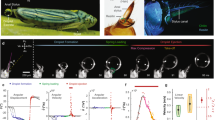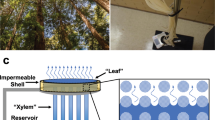Abstract
Despite the significant tension of xylem sap, many insects feed on the xylem sap. Because of the relatively little nutrient content of the xylem sap, feeding rates are up to 1000 times their body mass in a 24 hour period, which requires a suction pressure that may exceed the maximum tension that muscles can generally generate. This review focuses on the mechanical aspects of xylem sap feeding, especially in estimating the xylem sap tension and the suction pressure for xylem sap drinking. We discuss the inconsistencies of xylem sap feeding under tension with the maximum tension of the muscles, and present an overview of possible explanations for this discrepancy. It is expected that X-ray visualization techniques and microfluidics using hydrogel can be effectively used to elucidate the mechanics of xylem sap feeding.
Similar content being viewed by others
References
Raven JA. Phytophages of xylem and phloem: a comparison of animal and plant sap-feeders. Adv Ecol Res. 1983; 13:136–204.
Pollard DG. Stylet penetration and feeding damage of Eupteryx melissae Curtis (Hemiptera, Cicadellidae) on sage. B Entomol Res. 1968; 58:55–71.
Esau K. Plants, viruses and insects. Cambridge: Harvard University Press; 1961.
Mittler TE. Studies on the feeding and nutrition of Tuberolachnus salignus (Gmelin)(Homoptera: Aphididae). I. The uptake of phloem sap. J Exp Biol. 1957; 34:334–341.
Mittler TE. Studies on the feeding and nutrition of Tuberolachnus salignus (Gmelin)(Homoptera: Aphididae). II. The nitrogen and sugar composition of ingested phloem sap and excreted honeydew. J Exp Biol. 1958; 35:74–84.
Mittler TE. Water tensions in plants-an entomological approach. Ann Entomol Soc Am. 1967; 60:1074–1076.
Wiegert RG. The ingestion of xylem sap by meadow spittlebugs, Philaenus spumarius (L.) Am Midl Nat. 1964; 71: 422–428.
Horsfield D. Evidence for xylem feeding by Philaenus spumarius (L.) (Homoptera: Cercopidae). Entomol Exp Appl. 1978; 24:95–99.
Pockman WT, Sperry JS, O’Leary JW. Sustained and significant negative water pressure in xylem. Nature. 1995; 378:715–716.
Schmidt-Nielsen K. Animal Physiology: adaptation and environment. Cambridge: Cambridge University Press; 1975.
Crews L, McCully M, Canny M, Huang C, Ling L. Xylem feeding by spittlebug nymphs: some observations by optical and cryo-scanning electron microscopy. Am J Bot. 1998; 85:449–460.
Redak RA, Purcell AH, Lopes JRS, Blua MJ, Mizell RF, Andersen PC. The biology of xylem fluid-feeding insect vectors of Xylella fastidiosa and their relation to disease epidemiology. Annu Rev Entomol. 2004; 49:243–270.
Scholander PF, Bradstreet ED, Hemmingsen EA, Hammel HT. Sap pressures in vascular plants negative hydrostatic pressure can be measured in plants. Science. 1965; 148:339–346.
Wei C, Tyree MT, Steudle E. Direct measurement of xylem pressure in leaves of intact maize plants. A test of the cohesiontension theory taking hydraulic architecture into consideration. Plant Physiol. 1999; 121:1191–1205.
Tyree MT, Zimmermann MH. Xylem Structure and the Ascent of Sap. 2nd ed. Berlin: Springer; 2002.
Andersen PC, Brodbeck BV, Mizell RF. Feeding by the leafhopper Homalodisca coagulata in relation to xylem fluid chemistry and tension. J Insect Physiol. 1992; 38:611–622.
Apfel RE. Acoustic cavitation inception. Ultrasonics. 1984; 22:167–173.
Greenspan M, Techiegg CE. Radiation-induced acoustic cavitation; apparatus and some results. J Res NBS C Eng Inst. 1967; 71:299–311.
Malone M, Watson R, Pritchard J. The spittlebug Philaenus spumarius feeds from mature xylem at the full hydraulic tension of the transpiration stream. New Phytol. 1999; 143:261–271.
Lee SJ, Kim BH, Lee JY. Experimental study on the fluid mechanics of blood sucking in the proboscis of a female mosquito. J Biomech. 2009; 42:857–864.
Borrell BJ. Mechanics of nectar feeding in the orchid bee Euglossa imperialis: pressure, viscosity and flow. J Exp Biol. 2006; 209:4901–4907.
May PG. Nectar uptake rates and optimal nectar concentrations of two butterfly species. Oecologia. 1985; 66:381–3896.
Pivnick KA, McNeil JN. Effects of nectar concentration on butterfly feeding: measured feeding rates for Thymelicus lineola (Lepidoptera: Hesperiidae) and a general feeding model for adult Lepidoptera. Oecologia. 1985; 66: 226–237.
Kingsolver JG, Daniel TL. Mechanical determinants of nectar feeding strategy in hummingbirds: energetics, tongue morphology, and licking behavior. Oecologia. 1983; 60:214–226.
Bennet-Clark HC. Negative pressures produced in the pharyngeal pump of the blood-sucking bug, Rhodnius prolixus. J Exp Biol. 1963; 40:223–229.
Sperry JS, Saliendra NZ, Pockman WT, Cochard H, Cruiziat P, Davis SD, Ewers FW, Tryee MT. New evidence for large negative xylem pressures and their measurement by the pressure chamber method. Plant Cell Environ. 1996; 19:427–436.
Tyree MT, Sperry JS. Vulnerability of xylem to cavitation and embolism. Annu Rev Plant Phys. 1989; 40:19–36.
Pollard DG. Plant penetration by feeding aphids (Hemiptera, Aphidoidea): a review. B Entomol Res. 1973; 62:631–714.
Miles PW. The saliva of Hemiptera. Adv Insect Physiol. 1972; 9:183–255.
Leighton TG. The acoustic bubble. San Diego: Academic Press; 1994.
Kim BH, Kim HK, Lee SJ, Experimental analysis of the bloodsucking mechanism of female mosquitoes. J Exp Biol. 2011; 214:1163–1169.
Prakash M, Steele M. The hungry fly: Hydrodynamics of feeding in the common house fly. Phys Fluids. 2011; 23:091110.
Brodersen CR, McElrone AJ, Choat B, Matthews MA, Shackel KA. The dynamics of embolism repair in xylem: In vivo visualizations using high-resolution computed tomography. Plant Physiol. 2010; 154:1088–1095.
Brodersen CR, McElrone AJ, Choat B, Lee EF, Shackel KA, Matthews MA. In vivo visualizations of drought-induced embolism spread in Vitis vinifera. Plant Physiol. 2013; 161:1820–1829.
Lee SJ, Hwang BG, Kim HK. Hydraulic characteristics of water-refilling process in excised roots of Arabidopsis. Planta, 2013; 238:307–315.
Briggs LJ. Limiting negative pressure of water. J Appl Phys. 1950; 21:721–722.
Rein M, Meier GEA. On the influence of different parameters on heterogeneous shock cavitation. J Acoust Soc Am. 1990; 88:1921–1928.
Wilson DA, Hoyt JW, McKune JW. Measurement of tensile strength of liquids by an explosion technique. Nature. 1975; 253:723–725.
Wheeler TD, Stroock AD. The transpiration of water at negative pressures in a synthetic tree. Nature. 2008; 455: 208–212.
Vincent O, Marmottant P, Quinto-Su PA, Ohl CD. Birth and Growth of cavitation bubbles within water under tension confined in a simple synthetic tree. Phys Rev Lett. 2012; 108:184502.
Holtta T, Vesala T, Nkinmaa E. A model of bubble growth leading to xylem conduit embolism. J Theor Biol. 2007; 249: 111–123.
Author information
Authors and Affiliations
Corresponding author
Rights and permissions
About this article
Cite this article
Kim, W. Mechanics of xylem sap drinking. Biomed. Eng. Lett. 3, 144–148 (2013). https://doi.org/10.1007/s13534-013-0104-0
Received:
Accepted:
Published:
Issue Date:
DOI: https://doi.org/10.1007/s13534-013-0104-0




